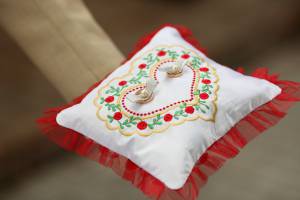
There are all kinds of traditions that continue through the world. Many have similarities while others can be vastly different.
If you’re trying to plan a unique ceremony for your special day, check out some of these special wedding traditions from around the world.
Wedding Traditions from other Cultures
- Congo – Brides and grooms aren’t allowed to smile on their wedding day. When they do, it shows that they aren’t serious about the marriage.
- China – The bride travels to the groom’s home in a decorated sedan chair. Attendants take care of the bride on the journey by holding parasols to shield her from the elements. They throw rice at the chair as a sign of prosperity and health. Female bridesmaids put the groom through a series of tests for him to prove his worthiness of the bride. He must give them envelopes of money before they’ll allow him to have their friend.
- Fiji – The potential bridegroom must present his father with a whale’s tooth when he asks for her hand in marriage.
- Jamaica – The bride is paraded through the streets. If the villagers go home, it means she didn’t look her best. She must go home and spruce herself up for another go.
Some Other Cultures Practices
- Guatemala – The groom’s parents host the reception party. The groom’s mother breaks a ceramic bell filled with grains to give the couple prosperity.
- Germany – The guests break porcelain dishes in front of the new home. The bride and groom are to clean these dishes up together as a demonstration of working together to overcome anything.
- Scotland – Gretna Green is the place to elope. In medieval times, Gretna Green would marry young couples who did not always have parental permission.
- Kenya – The bride’s father spits on her as she leaves the reception. It’s thought to preempt fate by not seeming too supportive of the couple.
- Greece – The best man (or groom’s best friend) shaves the groom before the wedding. The new mother-in-law feeds him honey and almonds.
- Japan – A Shinto bride wears white from head to toe. The head covering is thought to hide the horns of jealousy toward her new mother-in-law. The white symbolizes her maidenhood.
- Norway – The traditional cake is called kransekake. It’s a tower of almond cake rings stacked on top of each other. The center is often filled with a wine bottle. The bride may wear a gold and silver crown with small trinkets as part of her wedding finery. As she moves, the trinkets jingle, which scares off the evil spirits.
- Russia – Couples partake of a sweetbread called karavaya which is decorated with grains of wheat for fertility. Whoever takes the largest bite without using their hands is thought to be the head of the family.
As you go through this list, you might notice that many of the wedding traditions are similar to customs we have here. It just shows that we’re more alike than we think.


